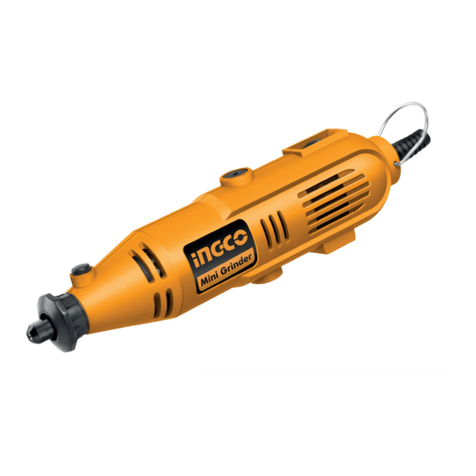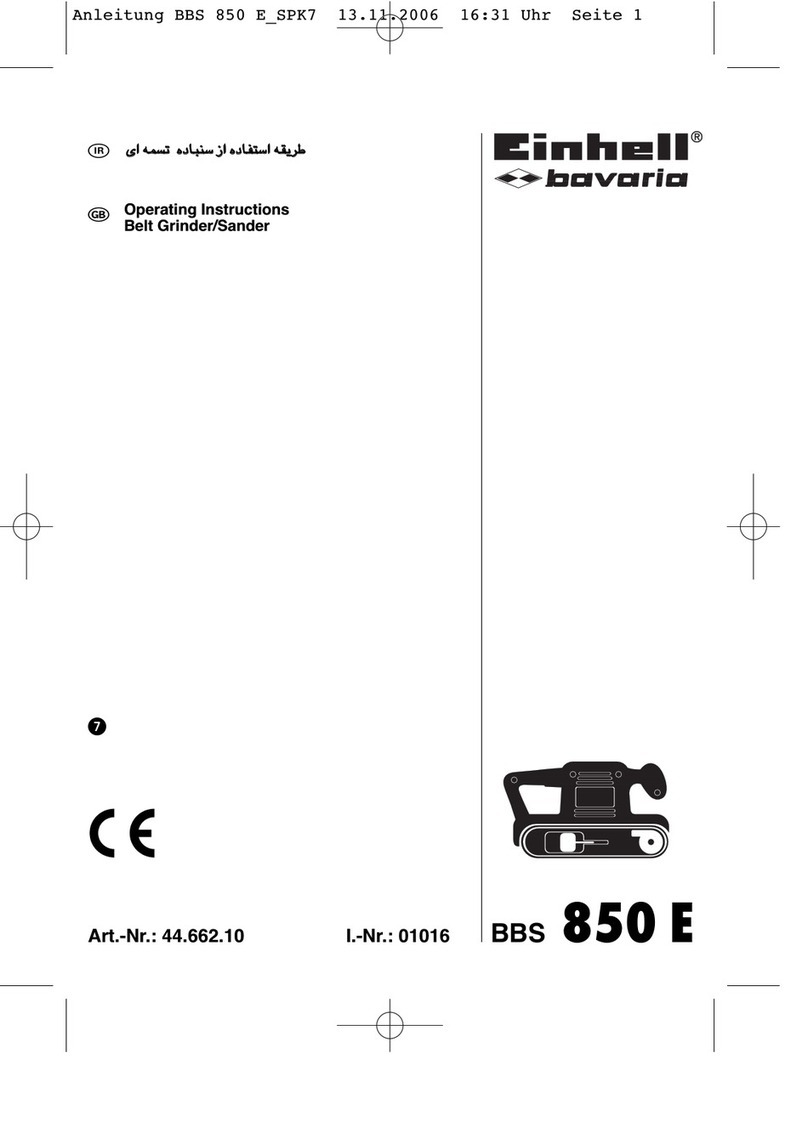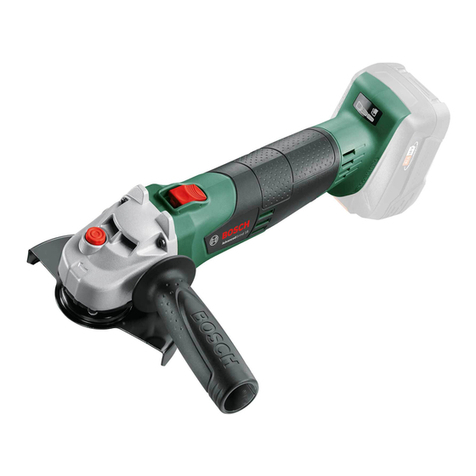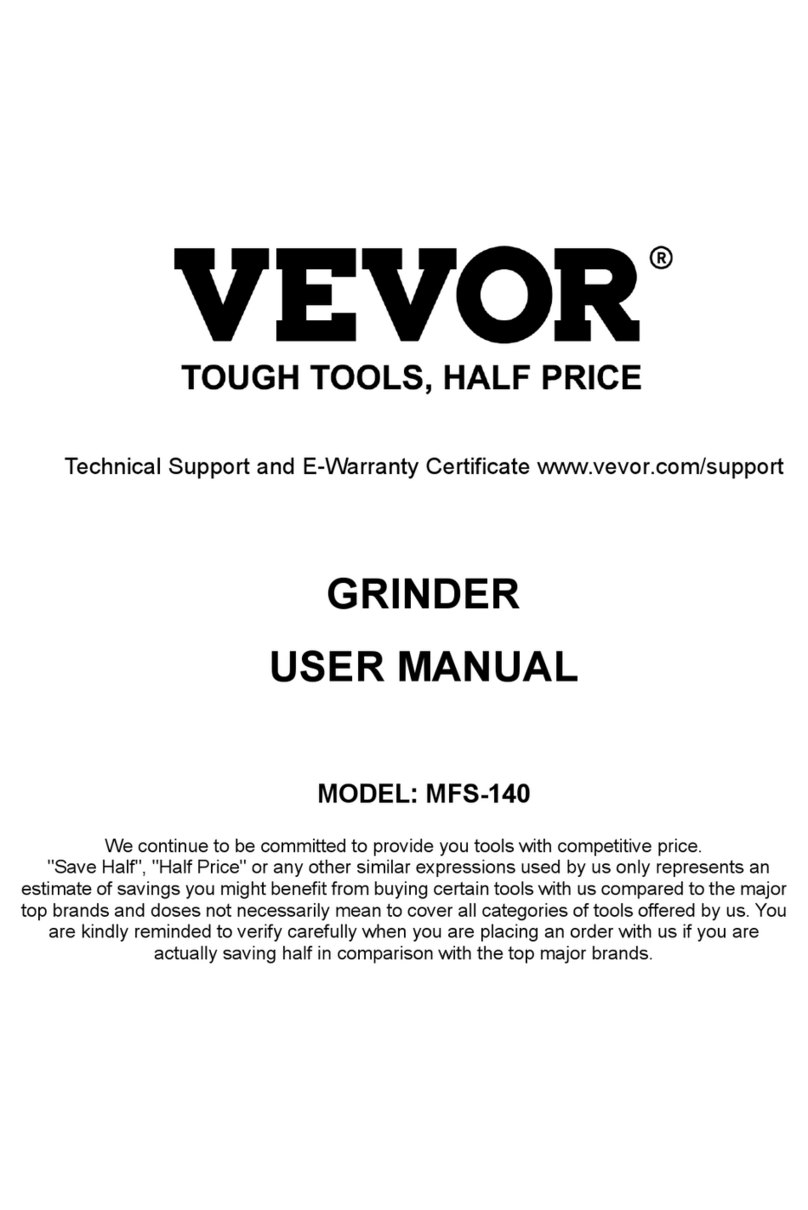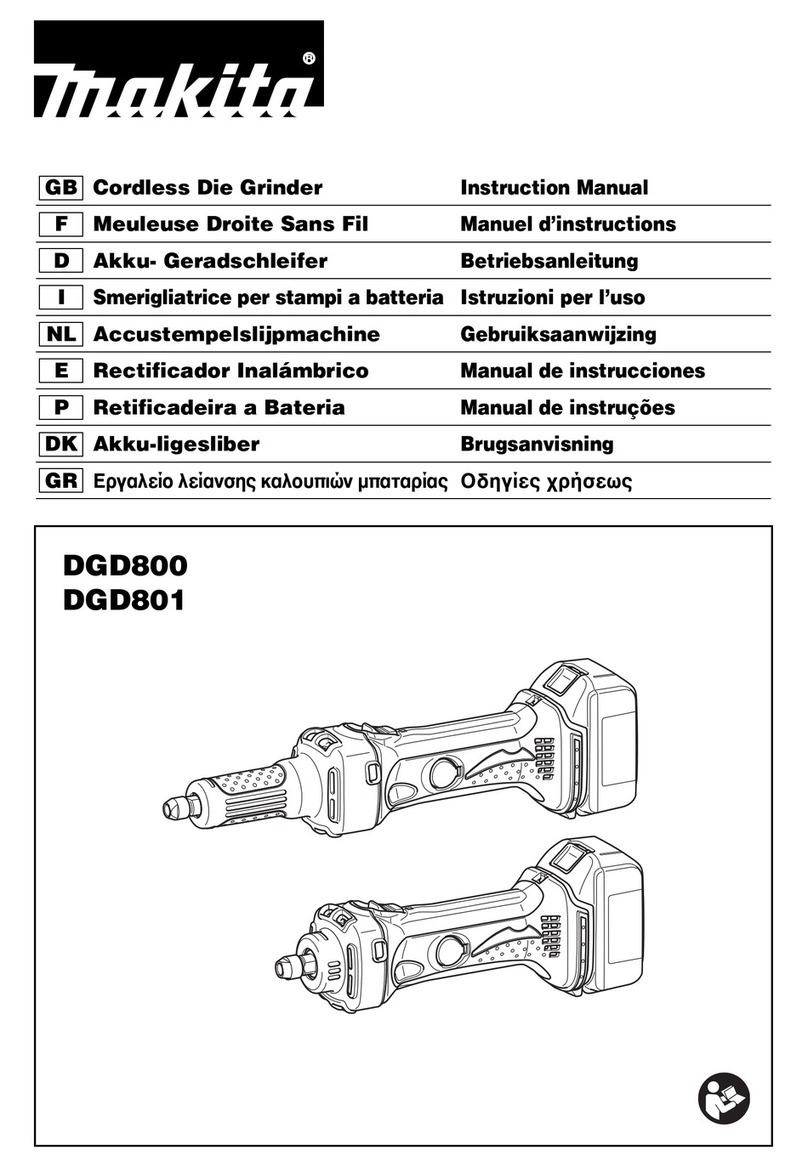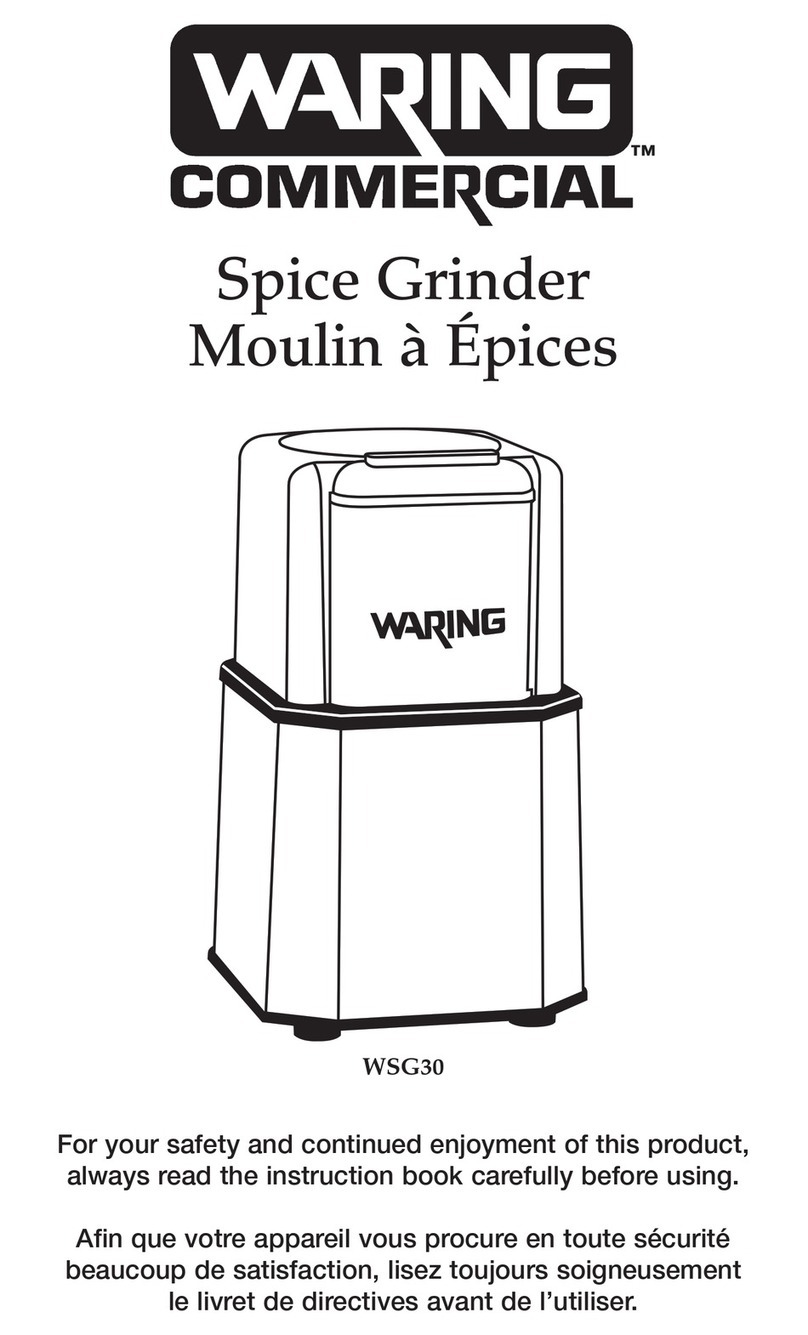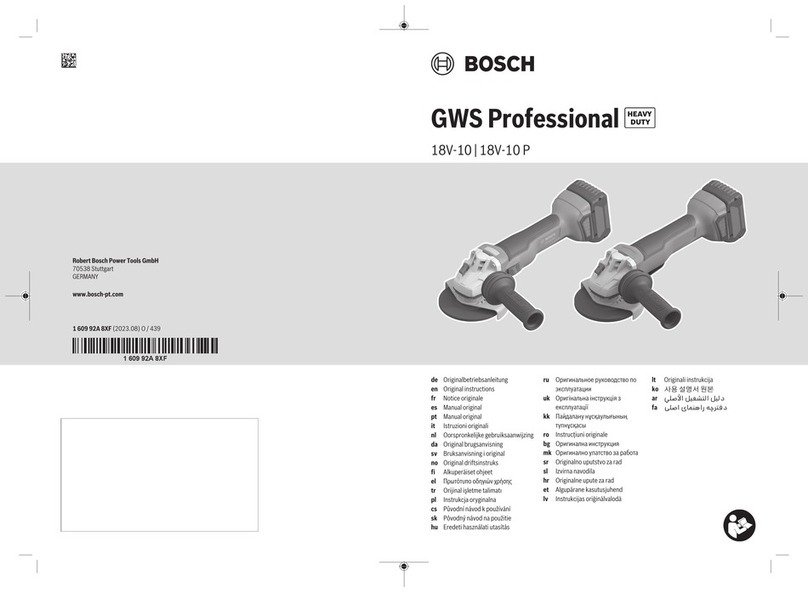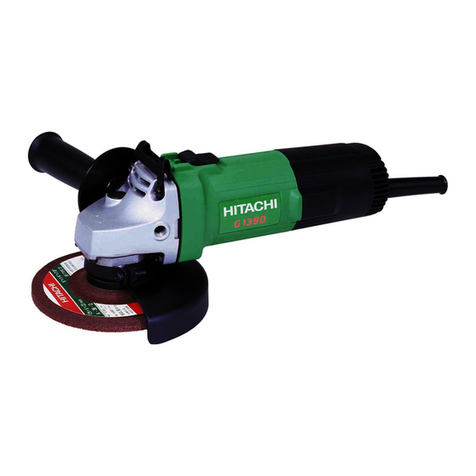Ingco AG23508 User manual

Angle Grinder
EN
Angle Grinder
AG23508 UAG23508 AG23508-1 UAG23508-1
AG23508-6 AG23508S-2 AG23508.1 AG23508.8 AG23508E

English Page 3-19
2

3|English
The symbols in instruction manual and the label on the tool
Double insulated for additional protection.
Read the instruction manual before using.
CE conformity.
Wear safety glasses, hearing protection and dust mask.
Waste electrical products should not be disposed of with household waste.
Please recycle where facilities exist. Check with your Local Authority or
retailer for recycling advice.
Safety alert.
Please only use the accessories supported by the manufacture.

4|English
GENERAL POWER TOOL SAFETY WARNINGS
WARNING Read all safety warnings and all instructions.Failure to
follow the warnings and instructions may result in electric shock, fire and/or
serious injury.
Save all warnings and instructions for future reference.
The term "power tool" in the warnings refers to your mains-operated (corded)
power tool or battery-operated (cordless) power tool.
1) Work area safety
a) Keep work area clean and well lit. Cluttered and dark areas invite
accidents.
b) Do not operate power tools in explosive atmospheres, such as
in the presence of flammable liquids, gases or dust. Power tools
create sparks which may ignite the dust or fumes.
c) Keep children and bystanders away while operating a power
tool. Distractions can cause you to lose control.
2) Electrical safety
a) Power tool plugs must match the outlet. Never modify the plug
in any way. Do not use any adapter plugs with earthed
(grounded) power tools. Unmodified plugs and matching outlets will
reduce risk of electric shock.
b) Avoid body contact with earthed or grounded surfaces such as
pipes, radiators, ranges and refrigerators. There is an increased
risk of electric shock if your body is earthed or grounded.
c) Do not expose power tools to rain or wet conditions. Water
entering a power tool will increase the risk of electric shock.
d) Do not abuse the cord. Never use the cord for carrying, pulling
or unplugging the power tool. Keep cord away from heat, oil,
sharp edges or moving parts. Damaged or entangled cords
increase the risk of electric shock.
e) When operating a power tool outdoors, use an extension cord
suitable for outdoor use. Use of a cord suitable for outdoor use
reduces the risk of electric shock.
f) If operating a power tools in a damp location is unavoidable, use

a residual current device (RCD) protected supply. Use of an RCD
reduces the risk of electric shock.
3) Personal safety
a) Stay alert, watch what you are doing and use common sense
when operating a power tool. Do not use a power tool while you
are tired or under the influence of drugs, alcohol or medication.
A moment of inattention while operating power tools may result in
serious personal injury.
b) Use personal protective equipment. Always wear eye protection.
Protective equipment such as dust mask, non-skid safety shoes,
hard hat, or hearing protection used for appropriate conditions will
reduce personal injuries.
c) Prevent unintentional starting. Ensure the switch is in the off-
position before connecting to power source and/or battery pack,
picking up or carrying the tool. Carrying power tools with your
finger on the switch or energizing power tools that have the switch on
invites accidents.
d) Remove any adjusting key or wrench before turning the power
tool on. A wrench or a key left attached to a rotating part of the
power tool may result in personal injury.
e) Do not overreach. Keep proper footing and balance at all times.
This enables better control of the power tool in unexpected
situations.
f) Dress properly. Do not wear loose clothing or jewellery. Keep
your hair, clothing and gloves away from moving parts. Loose
clothes, jewellery or long hair can be caught in moving parts.
g) If devices are provided for the connection of dust extraction and
collection facilities, ensure these are connected and properly
used. Use of dust collection can reduce dust-related hazards.
4) Power tool use and care
a) Do not force the power tool. Use the correct power tool for your
application. The correct power tool will do the job better and safer at
the rate for which it was designed.
b) Do not use the power tool if the switch does not turn it on and off.
Any power tool that cannot be controlled with the switch is dangerous
5|English

and must be repaired.
c) Disconnect the plug from the power source and/or the battery
pack from the power tool before making any adjustments,
changing accessories, or storing power tools. Such preventive
safety measures reduce the risk of starting the power tool accidentally.
d) Store idle power tools out of the reach of children and do not allow
persons unfamiliar with the power tool or these instructions to
operate the power tool. Power tools are dangerous in the hands of
untrained users.
e) Maintain power tools. Check for misalignment or binding of
moving parts, breakage of parts and any other condition that may
affect the power tools operation. If damaged, have the power tool
repaired before use. Many accidents are caused by poorly maintained
power tools.
f) Keep cutting tools sharp and clean. Properly maintained cutting tools
with sharp cutting edges are less likely to bind and are easier to control.
g) Use the power tool, accessories and tool bits etc. in accordance
with these instructions, taking into account the working
conditions and the work to be performed. Use of the power tool for
operations different from those intended could result in a hazardous
situation.
5) Service
a) Have your power tool serviced by a qualified repair person using
only identical.
This will ensure that the safety of the power tool is
maintained.
6|English

Additional Safety Warnings
SSaaffeettyy iinnssttrruuccttiioonnss ffoorr aallll ooppeerraattiioonnss
Safety Warnings Common for Grinding, Sanding, Wire Brushing, Polishing or Abrasive Cutting-
Off Operations:
a) This power tool is intended to function as a grinder, sander, wire brush, polisher or cut-off
tool. Read all safety warnings, instructions, illustrations and specifications provided with this
power tool. Failure to follow all instructions listed below may result in electric shock, fire and/or serious
injury.
b) Operations such as grinding, sanding, wire brushing, polishing or cutting-off are not
recommended to be performed with this power tool. Operations for which the power tool was not
designed may create a hazard and cause personal injury.
c) Do not use accessories which are not specifically designed and recommended by the tool
manufacturer. Just because the accessory can be attached to your power tool, it does not assure safe
operation.
d) The rated speed of the accessory must be at least equal to the maximum speed marked on the
power tool. Accessories running faster than their rated speed can break and fly apart.
e) The outside diameter and the thickness of your accessory must be within the capacity rating of
your power tool. Incorrectly sized accessories cannot be adequately guarded or controlled.
f) Threaded mounting of accessories must match the grinder spindle thread. For accessories mounted by
flanges, the arbour hole of the accessory must fit the locating diameter of the flange. Accessories that do not
match the mounting hardware of the power tool will run out of balance, vibrate excessively and may cause loss of
control.
g) Do not use a damaged accessory. Before each use inspect the accessory such as abrasive
wheels for chips and cracks, backing pad for cracks, tear or excess wear, wire brush for loose or
cracked wires. If power tool or accessory is dropped, inspect for damage or install an
undamaged accessory. After inspecting and installing an accessory, position yourself and
bystanders away from the plane of the rotating accessory and run the power tool at maximum no-
load speed for one minute. Damaged accessories will normally break apart during this test time.
h) Wear personal protective equipment. Depending on application, use face shield, safety
goggles or safety glasses. As appropriate, wear dust mask, hearing protectors, gloves and
workshop apron capable of stopping small abrasive or workpiece fragments. The eye protection
must be capable of stopping flying debris generated by various operations. The dust mask or respirator
must be capable of filtrating particles generated by your operation. Prolonged exposure to high intensity
noise may cause hearing loss.
i) Keep bystanders a safe distance away from work area. Anyone entering the work area must
wear personal protective equipment. Fragments of workpiece or of a broken accessory may fly away
and cause injury beyond immediate area of operation.
j) Hold the power tool by insulated gripping surfaces only, when performing an operation where
the cutting accessory may contact hidden wiring or its own cord. Cutting accessory contacting a
"live" wire may make exposed metal parts of the power tool "live" and could give the operator an electric
shock.
k) Position the cord clear of the spinning accessory. If you lose control, the cord may be cut or
snagged and your hand or arm may be pulled into the spinning accessory.
l) Never lay the power tool down until the accessory has come to a complete stop. The spinning
accessory may grab the surface and pull the power tool out of your control.
m) Do not run the power tool while carrying it at your side. Accidental contact with the spinning
accessory could snag your clothing, pulling the accessory into your body.
n) Regularly clean the power tool’s air vents. The motor’s fan will draw the dust inside the housing
7|English

and excessive accumulation of powdered metal may cause electrical hazards.
o) Do not operate the power tool near flammable materials. Sparks could ignite these materials.
p) Do not use accessories that require liquid coolants. Using water or other liquid coolants may
result in electrocution or shock.
Further safety instructions for all operations
Kickback and Related Warnings
Kickback is a sudden reaction to a pinched or snagged rotating wheel, backing pad, brush or any other
accessory. Pinching or snagging causes rapid stalling of the rotating accessory which in turn causes the
uncontrolled power tool to be forced in the direction opposite of the accessory’s rotation at the point of
the binding.
For example, if an abrasive wheel is snagged or pinched by the workpiece, the edge of the wheel that is
entering into the pinch point can dig into the surface of the material causing the wheel to climb out or kick
out. The wheel may either jump toward or away from the operator, depending on direction of the wheel’s
movement at the point of pinching. Abrasive wheels may also break under these conditions.
Kickback is the result of power tool misuse and/or incorrect operating procedures or conditions and can
be avoided by taking proper precautions as given below.
a) Maintain a firm grip on the power tool and position your body and arm to allow you to resist
kickback forces. Always use auxiliary handle, if provided, for maximum control over kickback or
torque reaction during start-up. The operator can control torque reactions or kickback forces, if proper
precautions are taken.
b) Never place your hand near the rotating accessory. Accessory may kickback over your hand.
c) Do not position your body in the area where power tool will move if kickback occurs. Kickback
will propel the tool in direction opposite to the wheel’s movement at the point of snagging.
d) Use special care when working corners, sharp edges etc. Avoid bouncing and snagging the
accessory. Corners, sharp edges or bouncing have a tendency to snag the rotating accessory and
cause loss of control or kickback.
e) Do not attach a saw chain woodcarving blade or toothed saw blade. Such blades create frequent
kickback and loss of control.
Additional safety instructions for grinding and cutting-off operations
Safety Warnings Specific for Grinding and Abrasive Cutting-Off Operations:
a) Use only wheel types that are recommended for your power tool and the specific guard
designed for the selected wheel. Wheels for which the power tool was not designed cannot be
adequately guarded and are unsafe.
b) The grinding surface of centre depressed wheels must be mounted below the plane of the
guard lip. An improperly mounted wheel that projects through the plane of the guard lip cannot be
adequately protected.
c) The guard must be securely attached to the power tool and positioned for maximum safety, so
the least amount of wheel is exposed towards the operator. The guard helps to protect the operator
from broken wheel fragments, accidental contact with wheel and sparks that could ignite clothing.
d) Wheels must be used only for recommended applications. For example: do not grind with the
side of cut-off wheel. Abrasive cut-off wheels are intended for peripheral grinding, side forces applied
to these wheels may cause them to shatter.
8|English

e) Always use undamaged wheel flanges that are of correct size and shape for your selected
wheel. Proper wheel flanges support the wheel thus reducing the possibility of wheel breakage. Flanges
for cut-off wheels may be different from grinding wheel flanges.
f) Do not use worn down wheels from larger power tools. Wheel intended for larger power tool is not
suitable for the higher speed of a smaller tool and may burst.
Additional safety instructions for cutting-off operations
Additional Safety Warnings Specific for Abrasive Cutting-Off Operations:
a) Do not “jam” the cut-off wheel or apply excessive pressure. Do not attempt to make an
excessive depth of cut. Overstressing the wheel increases the loading and susceptibility to twisting or
binding of the wheel in the cut and the possibility of kickback or wheel breakage.
b) Do not position your body in line with and behind the rotating wheel. When the wheel, at the
point of operation, is moving away from your body, the possible kickback may propel the spinning wheel
and the power tool directly at you.
c) When wheel is binding or when interrupting a cut for any reason, switch off the power tool and
hold the power tool motionless until the wheel comes to a complete stop. Never attempt to
remove the cut-off wheel from the cut while the wheel is in motion otherwise kickback may occur.
Investigate and take corrective action to eliminate the cause of wheel binding.
d ) Do not restart the cutting operation in the workpiece. Let the wheel reach full speed and
carefully re-enter the cut. The wheel may bind, walk up or kickback if the power tool is restarted in the
workpiece.
e) Support panels or any oversized workpiece to minimize the risk of wheel pinching and
kickback. Large workpieces tend to sag under their own weight. Supports must be placed under the
workpiece near the line of cut and near the edge of the workpiece on both sides of the wheel.
f) Use extra caution when making a “pocket cut” into existing walls or other blind areas. The
protruding wheel may cut gas or water pipes, electrical wiring or objects that can cause kickback.
Additional safety instructions for sanding operations
Safety Warnings Specific for Sanding Operations:
a) Do not use excessively oversized sanding disc paper. Follow manufacturers
recommendations, when selecting sanding paper. Larger sanding paper extending beyond the
sanding pad presents a laceration hazard and may cause snagging, tearing of the disc or kickback.
Additional safety instructions for polishing operations
Safety Warnings Specific for Polishing Operations:
a) Do not allow any loose portion of the polishing bonnet or its attachment strings to spin freely.
Tuck away or trim any loose attachment strings. Loose and spinning attachment strings can entangle
your fingers or snag on the workpiece.
Additional safety instructions for wire brushing operations
Safety Warnings Specific for Wire Brushing Operations:
a) Be aware that wire bristles are thrown by the brush even during ordinary operation. Do not
overstress the wires by applying excessive load to the brush. The wire bristles can easily penetrate
light clothing and/or skin.
b) If the use of a guard is recommended for wire brushing, do not allow any interference of the
wire wheel or brush with the guard. Wire wheel or brush may expand in diameter due to work load
and centrifugal forces.
9|English

10|English
used over longer period of time or not adequately managed and properly
maintained.
b) Injuries and damage to property to due to broken accessories that are
suddenly dashed.
Warning!This power tool produces an electromagnetic field during
operation. This field may under some circumstances interfere with active or
passive medical implants. To reduce the risk of serious or fatal injury, we
recommend persons with medical implants to consult their physician and the
medical implant manufacturer before operating this power tool.
Even when the power tool is used as prescribed it is not possible to
eliminate all residual risk factors. The following hazards may arise in
connection with the power tool’s construction and design:
a) Health defects resulting from vibration emission if the power tool is being
Residual risks

11|English
SPECIFICATIONS
GENERAL SAFETY RULES
(For All Tools)
WARNING! Read and understand all instructions.
Failure
Packed by plastic case(Only for AG23508-1, UAG23508-1, AG23508.1)
to follow all instructions listed below, may result
in electric shock, fire and/or serious personal injury.
SAVE THESE INSTRUCTIONS.
Work Area
1. Keep your work area clean and well lit.
Cluttered benches and dark areas invite
accidents.
2. Do not operate power tools in explosive
atmospheres, such as in the presence of
flammable liquids, gases or dust. Power tools
create sparks which may ignite the dust or fumes.
3. Keep bystanders, children, and visitors away
while operating a power tool. Distractions can
cause you to lose control.
Electrical Safety
4. Double insulated tools are equipped with a
polarized plug ( one blade is wider than the
other.) This plug will fit in a polarized outlet
only one way. If the plug does not fit fully in
the outlet, reverse the plug. If it still does not
fit, contact a qualified electrician to install a
polarized outlet. Do not change the plug in any
way. Double insulation eliminates the need for
the three wire grounded power cord and grounded
power supply system.
5. Avoid body contact with grounded surfaces
such as pipes, radiators, ranges and
refrigerators. There is an increased risk of
electric shock if your body is grounded.
6. Do not expose power tools to rain or wet
conditions. Water entering a power tool will
increase the risk of electric shock.
7. Do not abuse the cord. Never use the cord to
carry the tools or pull the plug from an outlet.
Keep cord away from heat, oil, sharp edges or
moving parts. Replace damaged cords
immediately. Damaged cords increase the risk of
electric shock.
8. When operating a power tool outside, use an
outdoor extension cord marked "W-A" or "W".
These cords are rated for outdoor use and reduce
the risk of electric shock.
Personal Safety
9. Stay alert, watch what you are doing and use
common sense when operating a power tool.
Do not use tool while tired or under the
influence of drugs, alcohol, or medication. A
moment of inattention while operating power tools
may result in serious personal injury.
Model No.
Rated power input
Rated voltage
deepsdaol-oN
Grinding spindle thread
Disc diameter
Wire brush diameter
AG23508
2350W
220-240V~50/60Hz
6700/min
M14
230mm
150m
AG23508-1
2350W
220-240V~50/60Hz
6700/min
M14
230mm
150m
UAG23508-1
2350W
m
AG23508E
2350W
220-240V~50/60Hz
6700/min
M14
230mm
150mm
AG
(SAA Plug)
23508S-2
2350W
220-240V~50/60Hz
6700/min
M14
230mm
150mm
AG23508-6(ISRAEL Plug)
2350W
220-240V~50/60Hz
6700/min
M14
230mm
150mm
AG23508.1
2350W
220-240V~50/60Hz
6700/min
M14
230mm
150mm
UAG23508
2350W
110-120V~50/60Hz
110-120V~50/60Hz
6300/min
5/8˝-11
9˝
5-7/8˝
6300/min
5/8˝-11
9˝
5-7/8˝
Model No.
Rated power input
Rated voltage
deepsdaol-oN
Grinding spindle thread
Disc diameter
Wire brush diameter
AG23508.8
(BS Plug)
2350W
220-240V~50/60Hz
6700/min
M14
230mm
150mm

12|English
Tool Use and Care
15. Use clamps or other practical way to secure
and support the workpiece to a stable platform.
Holding the work by hand or against your body is
unstable and may lead to loss of control.
16. Do not force tool. Use the correct tool for your
application. The correct tool will do the job better
and safer at the rate for which it is designed.
17. Do not use tool if switch does not turn it on or
off. Any tool that cannot be controlled with the
switch is dangerous and must be repaired.
18. Disconnect the plug from the power source
before making any adjustments, changing
accessories, or storing the tool. Such
preventive safety measures reduce the risk of
starting the tool accidentally.
19. Store idle tools out of reach of children and
other untrained persons. Tools are dangerous in
the hands of untrained users.
20. Maintain tools with care. Keep cutting tools
sharp and clean. Properly maintained tools with
sharp cutting edges are less likely to bind and are
easier to control.
21. Check for misalignment or binding of moving
parts, breakage of parts, and any other
condition that may affect the tool’s operation.
If damaged, have the tool serviced before
using. Many accidents are caused by poorly
maintained tools.
22.
Use only accessories that are recommended
by the manufacturer for your model.
Accessories that may be suitable for one tool, may
become hazardous when used on another tool.
Service
23. Tool service must be performed only by
qualified repair personnel. Service or
maintenance performed by unqualified personnel
could result in a risk of injury.
24. When servicing a tool, use only identical
replacement parts. Follow instructions in the
Maintenance section of this manual. Use of
unauthorized parts or failure to follow
Maintenance instructions may create a risk of
electric shock or injury.
USE PROPER EXTENSION CORD. Make sure your
extension cord is in good condition. When using an
extension cord, be sure to use one heavy enough to
carry the current your product will draw. An
undersized cord will cause a drop in line voltage
resulting in loss of power and overheating. Table 1
shows the correct size to use depending on cord
length and nameplate ampere rating. If in doubt, use
the next heavier gage. The smaller the gage number,
the heavier the cord.
3. Hold tool by insulated gripping surfaces when
performing an operation where the cutting tool
may contact hidden wiring or its own cord.
Contact with a "live" wire will make exposed metal
parts of the tool "live" and shock the operator.
4. When using depressed center grinding wheels,
be sure to use only fiberglass-reinforced
wheels.
5. Always use safety glasses or goggles.
Ordinary eye or sun glasses are NOT safety
glasses.
6. Check the wheel carefully for cracks or
damage before operation. Replace cracked or
damaged wheel immediately. Run the tool
(with guard) at no load for about a minute,
holding tool away from others. If wheel is
SPECIFIC SAFETY RULES
DO NOT let comfort or familiarity with product (gained
from repeated use) replace strict adherence to grinder
safety rules. If you use this tool unsafely or incorrectly,
you can suffer serious personal injury.
1. Always use proper guard with grinding wheel.
A guard protects operator from broken wheel
fragments.
2. Accessories must be rated for at least the
speed recommended on the tool warning label.
Wheels and other accessories running over rated
speed can fly apart and cause injury.
10. Dress properly. Do not wear loose clothing or
jewelry. Contain long hair. Keep your hair,
clothing, and gloves away from moving parts.
Loose clothes, jewelry, or long hair can be caught
in moving parts.
11. Avoid accidental starting. Be sure switch is off
before plugging in. Carrying tools with your
finger on the switch or plugging in tools that have
the switch on invites accidents.
12. Remove adjusting keys or wrenches before
turning the tool on. A wrench or a key that is left
attached to a rotating part of the tool may result in
personal injury.
13. Do not overreach. Keep proper footing and
balance at all times. Proper footing and balance
enables better control of the tool in unexpected
situations.
14. Use safety equipment. Always wear eye
protection. Dust mask, non-skid safety shoes,
hard hat, or hearing protection must be used for
appropriate conditions. Ordinary eye or sun
glasses are NOT eye protection.

13|English
flawed, it will likely separate during this test.
7. Use only flanges specified for this tool.
8. Be careful not to damage the spindle, the
flange (especially the installing surface) or the
lock nut. Damage to these parts could result in
wheel breakage.
9. NEVER use tool with wood cutting blades or
other sawblades. Such blades when used on a
grinder frequently kick and cause loss of
control leading to personal injury.
10. Hold the tool firmly.
11. Keep hands away from rotating parts.
12. Make sure cord is clear of wheel. Do not wrap
cord around your arm or wrist. If control of
tool is lost, cord may become wrapped around
you and cause personal injury.
13. Make sure the wheel is not contacting the
workpiece before the switch is turned on.
14. Before using the tool on an actual workpiece,
let it run for a while. Watch for vibration or
wobbling that could indicate poor installation
or a poorly balanced wheel.
15. Use the specified surface of the wheel to
perform the grinding.
16. Watch out for flying sparks. Hold the tool so
that sparks fly away from you and other
persons or flammable materials.
17. Do not leave the tool running. Operate the tool
only when hand-held.
18. Do not touch the workpiece immediately after
operation; it may be extremely hot and could
burn your skin.
19. ALWAYS wear proper apparel including long
sleeve shirts, leather gloves and shop aprons
to protect skin from contact with hot
grindings.
20. Use of this tool to grind or sand some
products, paints and wood could expose user
to dust containing hazardous substances. Use
appropriate respiratory protection.
21. After using the tool, make sure the wheel
rotation comes to a complete stop before
setting the tool down. Setting the tool down
with the wheel rotating can cause personal
injury.
SAVE THESE INSTRUCTIONS.
WARNING:
MISUSE or failure to follow the safety rules stated in
this instruction manual may cause serious personal
injury.
Symbols
The followings show the symbols used for tool.
・volts
・amperes
・hertz
・alternating current
・alternating or direct current
・no load speed
・Class II Construction
・revolutions or reciprocation per minute
FUNCTIONAL DESCRIPTION
CAUTION:
• Always be sure that the tool is switched off and
unplugged before adjusting or checking function on
the tool.
Shaft lock
1
CAUTION:
• Never actuate the shaft lock when the spindle is
moving. The tool may be damaged.
Press the shaft lock to prevent spindle rotation when
installing or removing accessories.
1. Shaft lock

14|English
The switch handle can be rotated to either 90° left or
right to fit your work needs. First, unplug the tool. Press
the lock button and rotate the switch handle to left or
right fully. The switch handle will be locked in that
position.
•
in the desired position before operation.
• Before plugging in the tool, always check to see
that the switch trigger actuates properly and
returns to the "OFF" position when released.
To prevent the switch trigger from being accidentally
pulled, a lock-off button is provided.
To start the tool, depress the lock-off button and then pull
the switch trigger. Release the switch trigger to stop.
• Before plugging in the tool, always check to see
that the switch trigger actuates properly and
returns to the "OFF" position when released.
• Switch can be locked in "ON" position for ease of
operator comfort during extended use. Apply
caution when locking tool in "ON" position and
maintain firm grasp on tool.
To start the tool, simply pull the switch trigger. Release
the switch trigger to stop.
For continuous operation, pull the switch trigger and
then push in the lock button, and then relese the switch
trigger.
To stop the tool from the locked position, pull the switch
trigger fully, then release it.
• Always be sure that the tool is switched off and
unplugged before carrying out any work on the
tool.
• When using a depressed center grinding
wheel/Multi-disc, flex wheel or wire wheel brush,
the wheel guard must be fitted on the tool so that
the closed side of the guard always points toward
the operator.
Switch handle mounting positions
CAUTION:
Switch action
CAUTION:
For tool with lock button
CAUTION:
ASSEMBLY
CAUTION:
Installing side grip (handle)
CAUTION:
Installing or removing wheel guard
CAUTION:
For tool with locking screw type wheel guard
2
1
1
2
3
Mount the wheel guard with the protrusion on the wheel
guard band aligned with the notch on the bearing box.
Then rotate the wheel guard around 180 degrees
counterclockwise. Be sure totighten the screw securely.
To remove wheel guard, follow the installation procedure
in reverse.
1. Wheel guard
2. Screw
3. Bearing box
1. Lock-on button
2. Switch trigger
1. Motor housing
2. Handle
• Always be sure that the side grip is installed
securely before operation.
Screw the side grip securely on the position of the tool
as shown in the figure.
1
2
Always make sure that the switch handle is locked

15|English
For tool with clamp lever type wheel guard
Loosen the lever on the wheel guard. Mount the wheel
guard with the protrusion on the wheel guard band
aligned with the notch on the bearing box. Then rotate
the wheel guard around to the position shown in the
figure. Tighten the lever to fasten the wheel guard. If the
lever is too tight or too loose to fasten the wheel guard,
loosen or tighten the nut to adjust the tightening of the
wheel guard band.
To remove wheel guard, follow the installation procedure
in reverse.
Installing or removing depressed center
grinding wheel
WARNING:
• Always use supplied guard when depressed center
grinding wheel/Multi-disc is on tool. Wheel can
shatter during use and guard helps to reduce
chances of personal injury.
Mount the inner flange onto the spindle. Fit the
wheel/disc on the inner flange and screw the lock nut
with its protrusion facing downward (facing toward the
wheel).
To tighten the lock nut, press the shaft lock firmly so that
the spindle cannot revolve, then use the lock nut wrench
To remove the wheel, follow the installation procedure in
reverse.
12
3
1
3
1
2
1
2
1. Lock nut wrench
2. Shaft lock
1. Lock nut
2. Depressed
center grinding
wheel
3. Inner flange
1. Nut
1. Bearing box
2. Wheel guard
3. Nut
• It should never be necessary to force the tool. The
weight of the tool applies adequate pressure.
Forcing and excessive pressure could cause
dangerous wheel breakage.
• ALWAYS replace wheel if tool is dropped while
grinding.
• NEVER bang or hit grinding disc or wheel onto
work.
• Avoid bouncing and snagging the wheel, especially
when working corners, sharp edges etc. This can
cause loss of control and kickback.
• NEVER use tool with wood cutting blades and
other sawblades. Such blades when used on a
grinder frequently kick and cause loss of control
leading to personal injury.
• Never switch on the tool when it is in contact with
the workpiece, it may cause an injury to operator.
• Always wear safety goggles or a face shield during
operation.
• After operation, always switch off the tool and wait
until the wheel has come to a complete stop before
putting the tool down.
ALWAYS hold the tool firmly with one hand on rear
handle and the other on the side handle. Turn the tool on
and then apply the wheel or disc to the workpiece.
In general, keep the edge of the wheel or disc at an
angle of about 15 degrees to the workpiece surface.
OPERATION
WARNING:
CAUTION:
Grinding and sanding operation
15
and securely tighten clockwise.

16|English
• Check operation of brush by running tool with no
load, insuring that no one is in front of or in line with
brush.
• Do not use brush that is damaged, or which is out
of balance. Use of damaged brush could increase
potential for injury from contact with broken brush
wires.
Unplug tool and place it upside down allowing easy
access to spindle. Remove any accessories on spindle.
Mount urethane washer then thread wire cup brush onto
spindle and tighten with supplied wrench. When using
brush, avoid applying too much pressure which causes
over bending of wires, leading to premature breakage.
• When using wire cup brush, mount urethane
washer to the spindle. It will make it easier to
remove wire cup brush.
1
2
1
Operation with wire cup brush (optional
accessory)
CAUTION:
NOTE:
Operation with wire wheel brush (optional
accessory)
CAUTION:
• Check operation of wire wheel brush by running
tool with no load, insuring that no one is in front of
or in line with the wire wheel brush.
• Do not use wire wheel brush that is damaged, or
which is out of balance. Use of damaged wire
wheel brush could increase potential for injury from
contact with broken wires.
• ALWAYS use guard with wire wheel brushes,
assuring diameter of wheel fits inside guard. Wheel
1. Wire wheel
brush
1. Wire cup brush
2. Urethane
washer
can shatter during use and guard helps to reduce
chances of personal injury.
Unplug tool and place it upside down allowing easy
access to spindle. Remove any accessories on spindle.
Thread wire wheel brush onto spindle and tighten with
the wrenches.
When using wire wheel brush, avoid applying too much
pressure which causes over bending of wires, leading to
premature breakage.
• Always be sure that the tool is switched off and
unplugged before attempting to perform inspection
or maintenance.
• Never use gasoline, benzine, thinner, alcohol or
the like. Discoloration, deformation or cracks may
result.
The tool and its air vents have to be kept clean.
Regularly clean the tool's air vents or whenever the
vents start to become obstructed.
1
2
1
2
MAINTENANCE
CAUTION:
Replacing carbon brushes
1. Commutator
2. Carbon brush
1. Exhaust vent
2. Inhalation vent

17|English
Use a screwdriver to remove the brush holder caps.
Take out the worn carbon brushes, insert the new ones
and secure the brush holder caps.
1
2
ACCESSORIES
CAUTION:
• These accessories or attachments are
recommended for use with your INGCO tool
specified in this manual. The use of any other
accessories or attachments might present a risk of
injury to persons. Only use accessory or
attachment for its stated purpose.
• Your tool is supplied with a guard for use with a
depressed center grinding wheel, multi-disc, flex
wheel and wire wheel brush. If you decide to use
your INGCO grinder with approved accessories
which you purchase from your INGCO distributor
,
be sure to obtain and use all necessary fasteners
and guards as recommended in this manual. Your
failure to do so could result in personal injury to you
and others.
1. Brush holder
cap
2. Screwdriver

Exploding view
AG23508,UAG23508,AG23508-1,UAG23508-1
AG23508-6,AG23508S-2,AG23508.1,AG23508.8,AG23508E
EXPLODING VIEW
18|English

19|English
SPARE PART LIST
AG23508,UAG23508,AG23508-1,UAG23508-1
AG23508-6,AG23508S-2,AG23508.1,AG23508.8,AG23508E
Spare Part List
No. Exploding view Qty
1 Special Spanner 1
2 Pressure Plate 1
3 Grinding Wheel 1
4 Pressure Plate 1
5 Guard 1
6 Screw M8×30 1
7 Nut M8 1
8 Main Spindle 1
9 Woodruff Key 4×13 1
10 Dustproof Cover 1
11 Screw M5×16 4
12 Spring Washer 5 4
13 Bearing Block 1
14 6202 Bearing 1
15 Press Plate of Bearing 1
16 Spring Washer 4 3
17 Screw M4×10 3
18 Steel Pipe 1
19/29
Large And Small Bevel Gea
r
1
20 Check Ring 14 1
21 Bearing 12×18×12 1
22 Check Ring 6 1
23 Screw ST4.8×30 4
24 Spring 1
25 Lock Pin 1
26 Reduction Gear Box 1
27 Wind Screen 1
28 Nut M8 1
No. Exploding view Qty
30 6201 Bearing 1
31 Press Plate of Bearing 1
32 Screw M4×10 3
33 Rotor 1
35 629 Bearing 1
36 Bearing Sheath 1
37 Cross Screw ST4.8×75 2
38 Stator 1
39 Side Handle 1
40 Nameplate 1
41 Cross Screw ST4.2×12 2
42 Right Brush Cover 1
43 Cross Screw ST4.2×12 2
44 Carbon Brush 2
45 Brush Holder 2
46 Housing 1
47 Right Handle 1
48 Cross Screw ST4.2×18 5
49 Cable Clip 1
50 Cross Screw ST4.2×16 2
51 Brand 1
52 Spring 2
53 Left Brush Cover 1
54 Switch 1
55 Left Handle 1
56 Cable Potector 1
57 Power cord 1
58 Capactior(option) 1

www.ingco.com
INGCO TOOLS CO.,LIMITED
MADE IN CHINA
1218.V12
AG23508 UAG23508 AG23508-1 UAG23508-1
AG23508-6 AG23508S-2 AG23508.1 AG23508.8 AG23508E
This manual suits for next models
7
Table of contents
Other Ingco Grinder manuals

